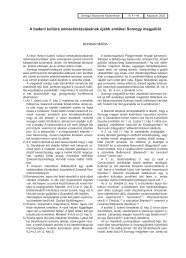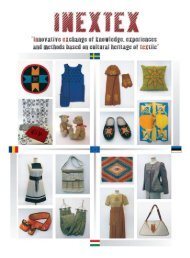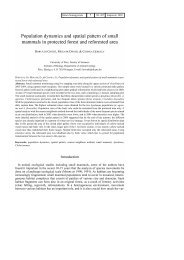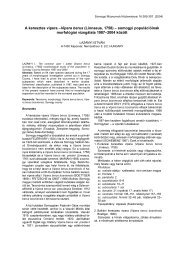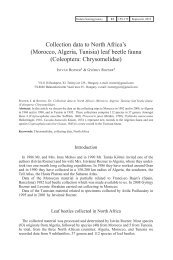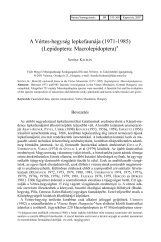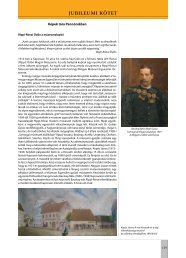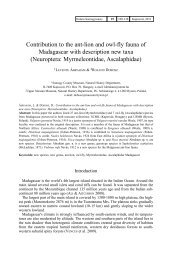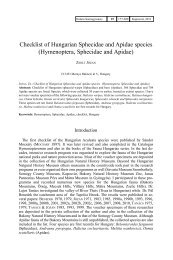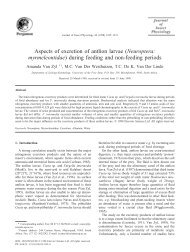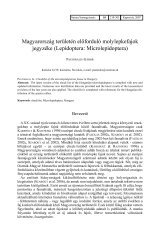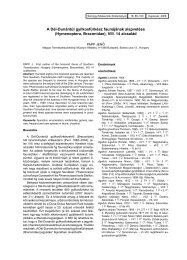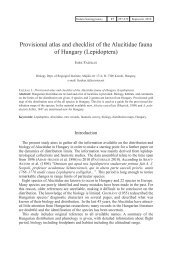Study on the Palaearctic Pristiphora species (Hymenoptera ...
Study on the Palaearctic Pristiphora species (Hymenoptera ...
Study on the Palaearctic Pristiphora species (Hymenoptera ...
Create successful ePaper yourself
Turn your PDF publications into a flip-book with our unique Google optimized e-Paper software.
214<br />
NATURA SOMOGYIENSIS<br />
Table D<br />
Subgenus <strong>Pristiphora</strong> Latreille, 1810. Abdominal sternites more or less yellow, ochraceous<br />
or red coloured. Abdominal tergites black or with red or white band or entirely yellow<br />
or yellow with black apex. Claw with small inner tooth or sometimes subbifid. If<br />
subbifid, abdominal tergites are black. Inner hind tibial spur equal or l<strong>on</strong>ger than hind<br />
basitarsus.<br />
1. Body large, males: 6.0 mm, females: 7.0-7.5 mm. Head finely punctured. Length of<br />
3rd antennal segment variable..........................................................................................2.<br />
- Body small, males: 4.0-4.5 mm, females: 5.0-6.5 mm. Head frequently densely punctured.<br />
Third antennal segment in females mostly shorter than larger ocular diameter (in<br />
P. fulvobalteata Takeuchi equal)......................................................................................3.<br />
2. Tergites 3-5 (except 2-2 rectangular spots <strong>on</strong> each tergites) reddish yellow, tergites<br />
2 and 6 dominantly or wholly black, tergites 1 and 7-9 black. The whole ventral<br />
abdomen reddish yellow in females. Costa light coloured, stigma dark brown. White or<br />
dirty whitish: labrum, clypeus (sometimes medially black), triangular supraclypeal spot,<br />
lower orbits (sometimes wholly black), pr<strong>on</strong>otal margin, mostly <strong>the</strong> tegula. Third antennal<br />
segment in female equal to <strong>the</strong> larger ocular diameter. Bases of hind coxae, fore and<br />
middle coxae entirely, apical half of hind femur (sometimes nearly all femora) and hind<br />
tarsi black. Male unknown. 7.0-7.5 mm..............................................P. c<strong>on</strong>dei Lindqvist<br />
Latvia, Finland, Northwest and Central Russia.<br />
(<strong>Pristiphora</strong> chalybeata Bens<strong>on</strong>, 1963 from Burma also runs here. Colour black with slightly bluish metallic<br />
sheen. Yellowish white: third abdominal segment (except for median dorsal patch), underside of 4th segment,<br />
mouthparts, trochanters, apex of fr<strong>on</strong>t femur, fr<strong>on</strong>t tibia, basal fifth of hind tibia, tarsus (except apical<br />
segment) of fr<strong>on</strong>t and middle legs and outer side of hind tarsus. Wings hyaline, with stigma and venati<strong>on</strong> black.<br />
7.5 mm. Sawsheath <strong>on</strong>ly slightly emarginated in dorsal view. Compare with P. albobalteata Takeuchi in couplet<br />
7).<br />
- Abdomen <strong>on</strong>ly ventrally and mainly <strong>the</strong> legs pale brown. Hind femora and tibiae<br />
white but hind tibiae with black apex. Labrum and clypeus reddish brown. O<strong>the</strong>rwise<br />
black. Third antennal segment in female shorter than larger ocular diameter. 6.0-7.0 mm.<br />
......................................................................................................P. gaunitzi Lindqvist<br />
Sweden.<br />
3. Abdomen with red middle band. Pics. 185 and 219.................................................4.<br />
- Abdomen without red band, black above or entirely yellow or yellow with black<br />
apex, or abdomen black with white middle band, sometimes <strong>on</strong>ly <strong>the</strong> last abdominal tergite<br />
light above, in this case, <strong>the</strong> light colour more extent <strong>on</strong> sternites and lateral part of<br />
tergites. Pics. 184, 198, 206-208, 210-213, 216 and 222................................................5.<br />
4. The middle band of abdomen without central black spots <strong>on</strong> tergites. Hind femora<br />
more or less black, but basal part always black. Melanic form rarely occurs. 5.5-6.5 mm.<br />
[Head and thorax black. Sometimes <strong>the</strong> labrum or <strong>the</strong> anterior margin of clypeus whitish.<br />
Hind corners (or sometimes hind margin) of pr<strong>on</strong>otum and tegula yellow. Abdomen variously<br />
coloured. In light forms, abdominal segments 2-5, and lateral parts of 6th tergite<br />
red. Melanic form with entirely black abdomen rarely occur especially in <strong>the</strong> nor<strong>the</strong>rn<br />
regi<strong>on</strong>s. Sometimes, <strong>the</strong> abdomen dominantly black, <strong>the</strong> red colour <strong>on</strong>ly indicated in <strong>the</strong><br />
middle tergites of <strong>the</strong> abdomen. Wings hyaline, costa and stigma light brown.] Fig. 185.<br />
............................................................................................................P. cincta Newman<br />
Western, Middle and Eastern Europe, Scandinavia, Russia throughout (except south and sou<strong>the</strong>ast) including<br />
Siberia, M<strong>on</strong>golia, Korea and North America.<br />
- Similar to <strong>the</strong> previous <strong>species</strong>, however, <strong>the</strong> middle red band of abdomen with fused<br />
pair of central spots <strong>on</strong> each tergites. Abdominal sternites 1-5, tergites 1-5, partly <strong>the</strong> 6,



